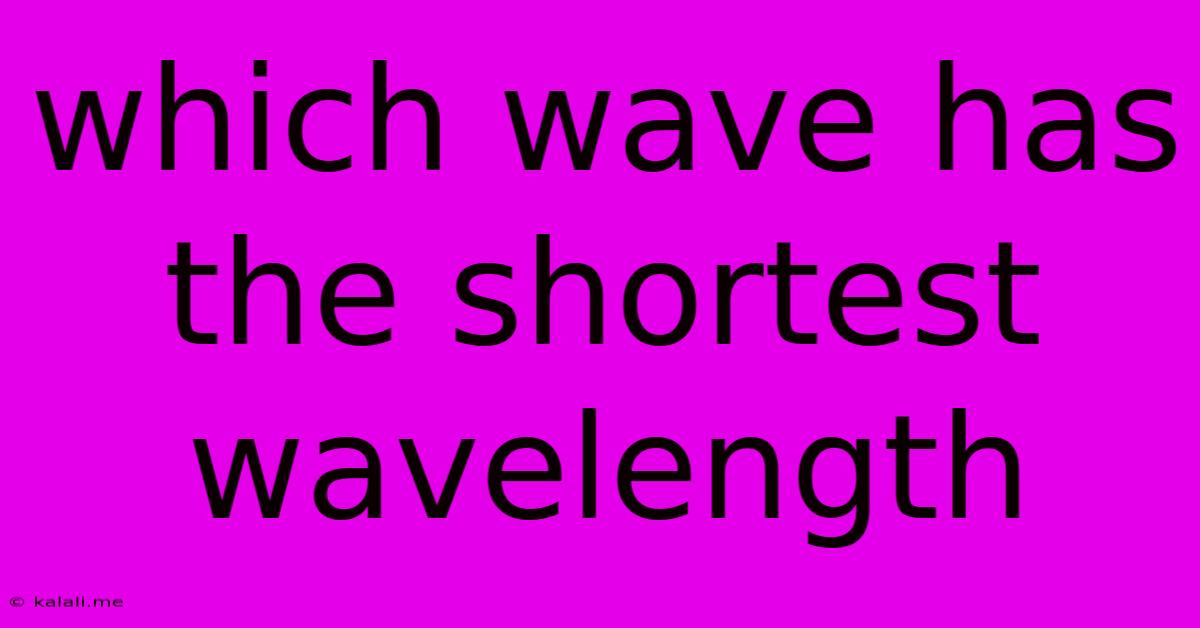Which Wave Has The Shortest Wavelength
Kalali
Jun 15, 2025 · 3 min read

Table of Contents
Which Wave Has the Shortest Wavelength? Exploring the Electromagnetic Spectrum
The question of which wave has the shortest wavelength leads us on a fascinating journey through the electromagnetic spectrum. This spectrum encompasses a broad range of waves, all sharing the fundamental characteristic of being electromagnetic radiation, but differing significantly in their wavelengths, frequencies, and energies. Understanding this spectrum is key to answering our question.
The electromagnetic spectrum ranges from radio waves with very long wavelengths to gamma rays with incredibly short wavelengths. Within this vast expanse, gamma rays hold the title of having the shortest wavelengths. These waves are incredibly energetic and have wavelengths typically measured in picometers (10<sup>-12</sup> meters) or even smaller.
Understanding Wavelength and the Electromagnetic Spectrum
Before diving deeper, let's clarify what wavelength actually is. Wavelength (λ) is the distance between two consecutive crests or troughs of a wave. Think of it as the length of one complete cycle of the wave. The electromagnetic spectrum organizes these waves based on their wavelengths, with each type possessing unique properties and applications.
Here's a brief overview of the electromagnetic spectrum, arranged from longest to shortest wavelength:
- Radio waves: These have the longest wavelengths, ranging from millimeters to kilometers. They're used in broadcasting, communication, and radar.
- Microwaves: Shorter than radio waves, microwaves are used in cooking, communication, and radar.
- Infrared radiation: Experienced as heat, infrared radiation is used in thermal imaging and remote controls.
- Visible light: This is the portion of the spectrum we can see, consisting of the colors of the rainbow from red (longest wavelength) to violet (shortest wavelength).
- Ultraviolet (UV) radiation: Shorter than visible light, UV radiation is responsible for sunburns and is used in sterilization techniques.
- X-rays: These have even shorter wavelengths than UV radiation and are used in medical imaging and material analysis.
- Gamma rays: Finally, gamma rays possess the shortest wavelengths and are the most energetic form of electromagnetic radiation. They are emitted by radioactive materials and nuclear reactions.
The Significance of Gamma Ray's Short Wavelength
The extremely short wavelength of gamma rays is directly related to their high frequency and energy. The relationship between wavelength (λ), frequency (ν), and the speed of light (c) is given by the equation: c = λν. Since the speed of light is constant, a shorter wavelength implies a higher frequency, and consequently, higher energy.
This high energy is what makes gamma rays so powerful and potentially dangerous. They can penetrate deeply into matter, causing ionization and potentially damaging biological tissue. However, they also find valuable applications in various fields, such as medical treatments (radiotherapy) and industrial processes.
In Conclusion
To reiterate, gamma rays possess the shortest wavelengths within the electromagnetic spectrum. Their incredibly short wavelengths, coupled with high frequency and energy, distinguish them from other forms of electromagnetic radiation and account for their unique properties and applications. Understanding the electromagnetic spectrum and the characteristics of its various components is crucial for appreciating the diverse ways in which electromagnetic waves interact with the world around us.
Latest Posts
Latest Posts
-
What Is A Factor Of 44
Jun 16, 2025
-
Which Of The Following Is Not A Strong Base
Jun 16, 2025
-
The Atomic Number Is Determined By The Number Of
Jun 16, 2025
-
Normal Profit Is Also Known As Economic Profit
Jun 16, 2025
-
What Is A Factor Of 50
Jun 16, 2025
Related Post
Thank you for visiting our website which covers about Which Wave Has The Shortest Wavelength . We hope the information provided has been useful to you. Feel free to contact us if you have any questions or need further assistance. See you next time and don't miss to bookmark.